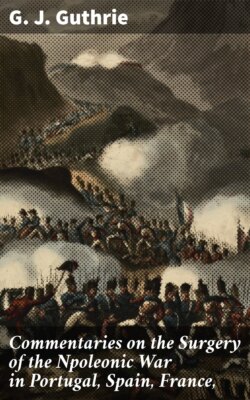Читать книгу Commentaries on the Surgery of the Npoleonic War in Portugal, Spain, France, - G. J. Guthrie - Страница 7
На сайте Литреса книга снята с продажи.
Оглавление[2] The India Company have supplied the principal hospital of each presidency with one good microscope at least; one of these, with a person who understands its use, should be attached (but is not) to the principal hospitals during the present war in the East.
64. In the irritable and sloughing state of stump alluded to, hemorrhages frequently take place from the small branches, or from the main trunks of the arteries, in consequence of ulceration; and it is not always easy to discover the bleeding vessel, or, when discovered, to secure it on the face of the stump; for as the ulcerative process has not ceased, and the end of the artery which is to be secured is not sound, no healthy action can take place; the ligature very soon cuts its way through, and the hemorrhage returns as violently as before, or some other branch gives way; and under this succession of ligatures and hemorrhages the patient dies.
Some surgeons have, in such cases, preferred cutting down upon the principal artery of the limb, in preference to performing another amputation, even when it is practicable; and they have sometimes succeeded in restraining the hemorrhage for a sufficient length of time to allow the stump to resume a more healthy action. This operation, although successful in some cases, will generally fail, and particularly if absolute rest cannot be obtained, when amputation will become necessary. The same objection of want of success may be made to amputation; on a due comparison of the whole of the attending circumstances, the operation of tying the artery in most cases is to be preferred in the first instance, and if that prove unsuccessful, then recourse is to be had to amputation; but this practice is by no means to be followed indiscriminately. The artery ought to be secured with reference to the mode of operating, as in aneurism, but the doctrines of this disease are not to be applied to it, because it is still a wounded vessel with an external opening.
To obviate all doubts, the part from which the bleeding comes should be well studied, and the shortest distance from the stump at which compression on the artery commands the bleeding carefully noted; at this spot the ligature should be applied, provided it be not within the sphere of the inflammation of the stump. In case the hemorrhage should only be restrained by pressure above the origin of the profunda, and repeated attempts to secure the vessel on the surface of the stump have failed, amputation is preferable to tying the artery in the groin, when the strength of the patient will bear it.
When hemorrhage takes place after amputation at or below the shoulder-joint, it is a dangerous occurrence. An incision should then be made through the integuments and across the great pectoral muscle, when the artery may be readily exposed, and a ligature placed upon it without difficulty anywhere below the clavicle.
If the state of the stump in any of these cases should appear to depend upon the bad air of the hospital, the patient had better be exposed to the inclemency of the weather than be allowed to remain in it.
In crowded hospitals, hemorrhages from the face of an irritable stump are not unfrequent, and often cause a great deal of trouble and distress. It is not a direct bleeding from a vessel of sufficient size to be discovered and secured by ligature, but an oozing from some part of the exposed granulations, which are soft, pale, and flaccid. On making pressure on them the hemorrhage ceases, but shortly after reappears, and even becomes dangerous. This hemorrhage is usually preceded by pain, heat, and throbbing in the surface from which it proceeds. There is irritation of the habit generally, and a tendency to direct debility. The proper treatment consists in the removal of the patient to the open air, with an antiphlogistic regimen in the first instance, followed by the use of quinine and acids; cold to the stump, in the shape of pounded ice or iced water. Escharotic and stimulating applications should be used with caution. If any of the styptics which are sometimes announced as infallible could be relied upon, their application in these cases would be most advantageous. The solution of the perchloride of iron is the best.
